Contents
Market Overview
Macro Review
Signature Bank, Silicon Valley Bank and Credit Suisse rocked markets this week. The pressure on Credit Suisse subsided with Swiss National Bank intervention, which allowed the bank to tender 20% of Eurobond debt, but questions over post-GFC bail-in securities remain. It was only on Monday when Axel Lehmann said state assistance wasn’t a topic, but in the absence of further Saudi support due to “regulatory concerns”, the 5-year CDS contract sharply rose above 1,000bps. The EuroStoxx Banks Index ended the week down 10% and the iTraxx Xover CDS Index widened 50bps, which highlights the fragility in European fixed income. Similarly, the pressure on First Republic Bank appeared to ease when 11 banks announced $30bn in deposits, but the equity traded down again on Friday. After the failure of Silicon Valley Bank and Signature Bank, the questions were around who could be next as U.S. banks were down 13% over the week (using BKX). In that vein and the systemic global risks, it was somewhat surprising that the ECB pressed ahead by raising policy rates by 50bps when 25bps seemed more prudent. Perhaps this is a further indication of just how far behind the curve the ECB is. Needless to say, the ECB’s terminal rate was revised down from 3.75% to 3.50% by HSBC and GS and more are likely to follow. The market has now begun to price in 21bps ahead of the FOMC on Wednesday, which steadily increased through last week from as low as 8bps. Meanwhile, China cut its RRR cut by 25bps, Goldman upgraded the country’s 2023 GDP growth to 6% from 5.5%,and improved Chinese demand expectations lifted crude oil briefly. Crude oil was still down 12% last week but dwarfed by the largest fall in yields in U.S. Treasuries since 1982 on Monday and the largest fall in German bund yields since German reunification on Wednesday.
EM Credit Update
Emerging market sovereign credit (cash bonds) ended the week -0.4% with spreads 21bps wider. Performance held up in light of extreme volatility in U.S. Treasuries driven by Silicon Valley Bank, Signature Bank, Credit Suisse and crude oil, which saw the 2-year fall 57bps and the 30-year fall 10bps. The emphasis is more on the volatility, rather than the magnitude of the move lower in yields, where the MOVE Index is comfortably above 160. Sovereign outperformers were Croatia, Qatar and Indonesia, while Tunisia, Zambia and Pakistan underperformed.
The Week Ahead
Key interest rate decisions are due out of the FOMC, BOE, Norges and SNB, as they follow the ECB who didn’t take their foot of the brakes in hiking 50bps. The Fed’s quarterly Summary of Economic Projections will also be an important market event. China may have cut their RRR by 25bps, but the 1-year and 5-year LPR rates are expected to remain unchanged at 3.65% and 4.30%, respectively. Instead, the focus is likely on President Xi’s visit to Moscow. Other EM interest rate decisions are due out of Brazil (13.75%), Nigeria (17.5%) and Turkey (8.5%). Finally, Malaysia, Mexico and South Africa will publish the latest CPI readings.
Highlights from emerging markets discussed below: Argentina reaches staff level agreement on fourth EFF review, China Two Sessions largely point to continuity for now, Lower interest rates in Brazil hinge on a credible fiscal rule by the Lula Administration and Bolivia fundamentals and assets under pressure.
Fixed Income
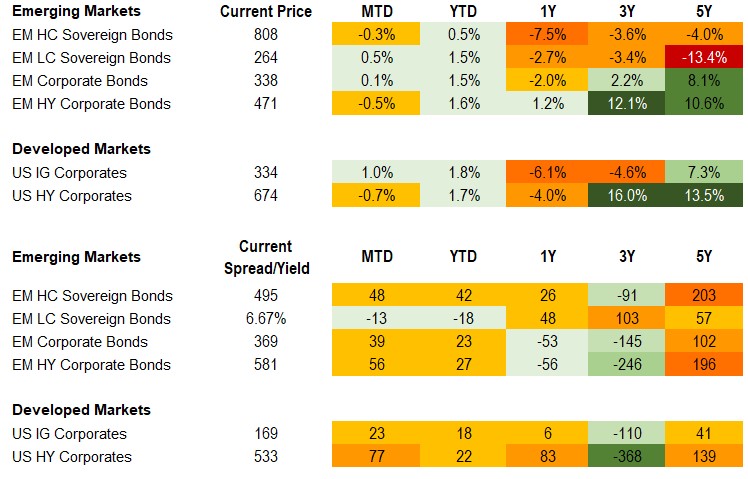
Equities
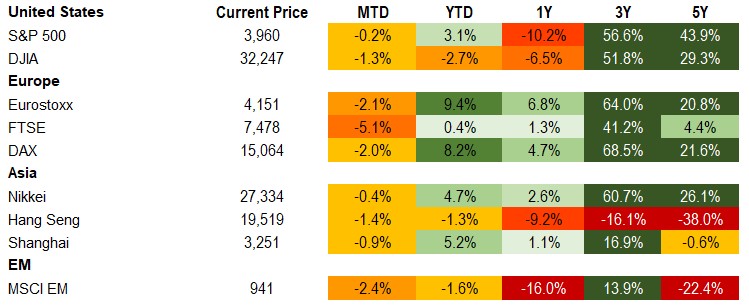
Commodities

Source for data tables: Bloomberg, JPMorgan, Gramercy. EM Fixed Income is represented by the following JPMorgan Indicies: EMBI Global, GBI-EM Global Diversified, CEMBI Broad Diversified and CEMBI Broad High Yield. DM Fixed Income is represented by the JPMorgan JULI Total Return Index and Domestic High Yield Index. Fixed Income, Equity and Commodity data is as of March 17, 2023 (mid-afternoon).
Emerging Markets Weekly Highlights
Argentina reaches staff level agreement on fourth EFF review
Event: The authorities and IMF concluded negotiations over the fourth review under Argentina’s EFF program which will trigger a $5.3bn disbursement upon board approval. The press release commended the authorities for prudent macroeconomic management in 2H22, including moderate outperformance relative to targets on fiscal and external measures. Additionally, the IMF team agreed to amend the net FX reserves target for this year due to the ongoing extreme drought, which is set to weigh on export receipts. At the same time, the IMF alluded to its disagreement with the multiple FX rate regime as well as the use of FX reserves for parallel market intervention. Meanwhile, inflation continued to accelerate in February, reaching 6.6% on a monthly basis and 102.5% in y/y terms. The Central Bank of Argentina (BCRA) responded with a 300bps hike in its policy, bringing the rate to 78%.
Gramercy commentary: We see continued compliance with the IMF program and flexibility with respect to criteria waivers by the Fund as constructive in preventing worst case macroeconomic conditions. We expect the market’s focus to deepen on electoral dynamics in the coming weeks and months with candidate announcements forthcoming and gubernatorial elections getting underway. Additionally, macroeconomic data will continue to be closely watched as pressure on net FX reserves, local rollovers, and very high inflation continue to pose challenges. Massa’s latest domestic debt swap has helped to alleviate, but not fully eliminate, risks in the local market while growing inflationary pressures will likely increase the demand for a change in policy approach.
China Two Sessions largely point to continuity for now
Event: China held the Two Sessions meetings over the last two weeks where the authorities set a 2023 growth target of around 5%, down from last year’s missed target of 5.5%. As expected, Li Qiang was appointed as the new Premier while PBOC Governor Yi Gang and Minister of Finance Liu Kun retained their positions. Premier Li struck a pro-business tone in his closing remarks while President Xi and Foreign Minister Qin Gang made critical remarks of the U.S. Data continued to affirm improvement in economic momentum with solid PMIs, retail sales, benign inflation, and easing contraction in property investment.
Gramercy commentary: The Two Sessions meetings conveyed desire for stability and continuity in the near-term with reliance on economic reopening rather excessive stimulus. We see Gang and Kun’s presence as positive in the near-term, reducing the risk of policy surprises but does not rule out changes as the year progresses and greater clarity emerges on the domestic recovery, external conditions, and financial regulation. The government’s stern comments against the U.S. are not overly escalatory in our opinion but rather reaffirming of their position. The upcoming visit by Taiwan President Tsai to the U.S. may trigger Chinese military exercises or drills to demonstrate force.
Lower interest rates in Brazil hinge on a credible fiscal rule by the Lula Administration
Event: In the coming days, Brazil’s government appears likely to present a new fiscal rule to replace the constitutional spending cap that President Lula has committed to abolish. This has been highly anticipated by the markets.
Gramercy commentary: Both the substance of the new fiscal rule (its credibility and likelihood to reverse deterioration in the key fiscal metrics) as well as the odds/timeline for its approval will matter a great deal for how markets react to the long-anticipated announcement. Our understanding is that Finance Minister Fernand Haddad has already coordinated the proposal’s essence with Planning Minister Simone Tebet and Trade Minister and Vice President Geraldo Alckmin, both of whom are seen as key market-friendly figures in the Lula Administration. However, the last word on the proposal before it is made public will come from President Lula himself. We believe he is highly unlikely to endorse a framework that could restrict his ambitious spending plans or jeopardize economic growth, which has clearly been Lula’s top priority since taking power on January 1st. A new rule that limits the prospects for significant fiscal expansion would be critical for anchoring medium-term inflation expectations and, as such, an important signpost on the outlook for monetary policy easing by the Central Bank of Brazil (BCB) in the second half of the year. The BCB and its President, Roberto Campos Neto, have been under serious political pressure to start easing policy amid falling current inflation and the highest real interest rates in global EM. The BCB has voiced concerns that fiscal loosening by the Lula Administration could lead to inflation re-accelerating and has demanded fiscal reassurances (in the form of a credible fiscal rule) before initiating a rate-cutting cycle.
Bolivia fundamentals and assets under pressure
Event: Fitch downgraded Bolivia’s ratings one-notch to B- with a negative outlook while S&P put its B ratings on watch for downgrade amid growing external financing pressure and political volatility. Bonds have traded down 10-15pts since the start of the year.
Gramercy commentary: We do not see the underperformance of Bolivian assets as surprising given the significant erosion of FX reserves in recent years to ~$700mm from over $8bn in 2018. and a deterioration in the fiscal position with a roughly 20% pt increase in debt to GDP since 2019 to around 80% and large fiscal deficit of around 8% of GDP. This combined with an upcoming $183mm Eurobond amortization in August and political infighting within the ruling MAS coalition, as well as jailing of the main opposition leader, has increased concerns over willingness and ability to pay debt. In the near-term, we expect macroeconomic and financing conditions to remain strained and asset prices to remain under pressure. Over the medium-term, improvement would require political changes that allow for better macroeconomic management and investment conditions to capitalize on the country’s natural resources.
Emerging Markets Technicals
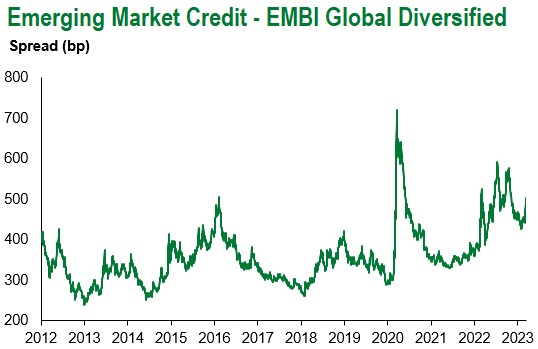
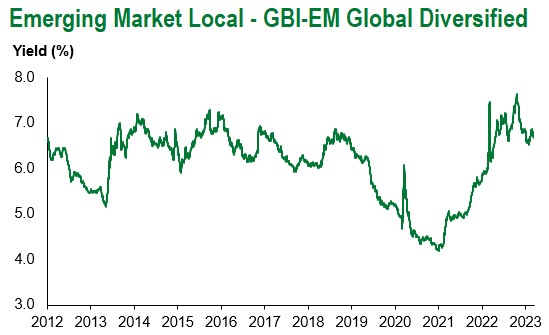
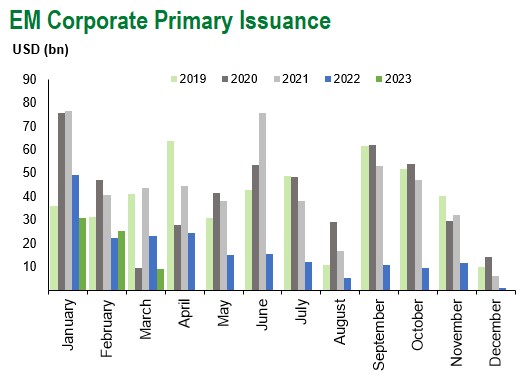
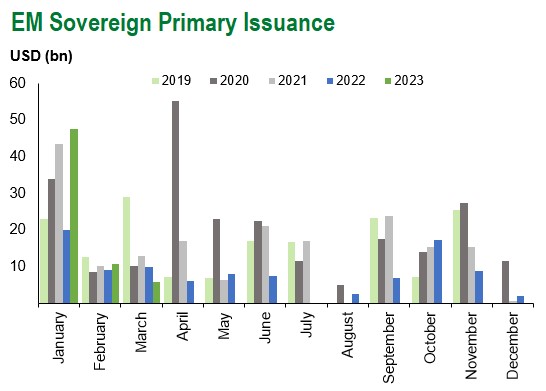
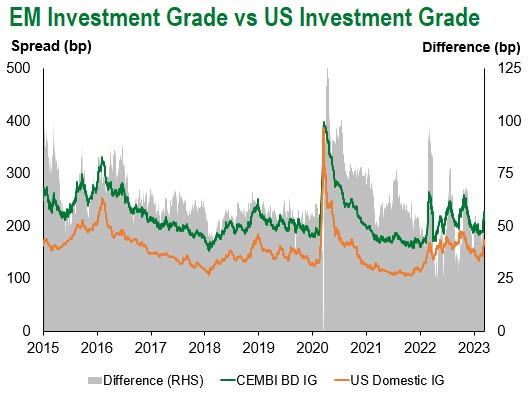
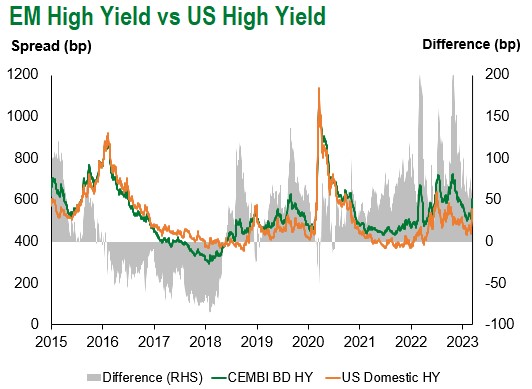
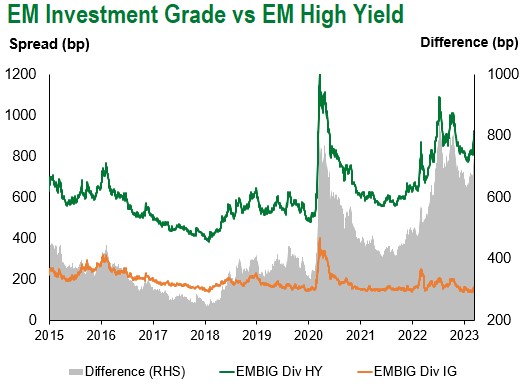
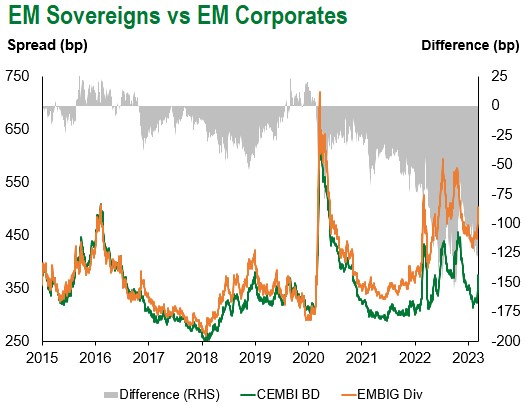
Emerging Markets Flows
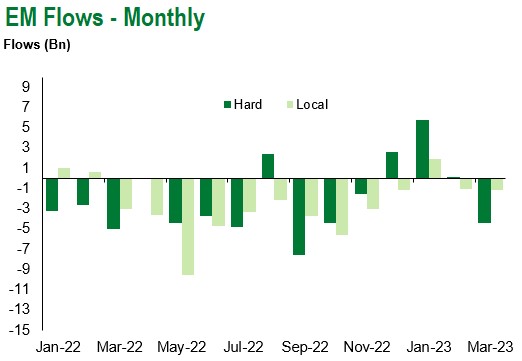
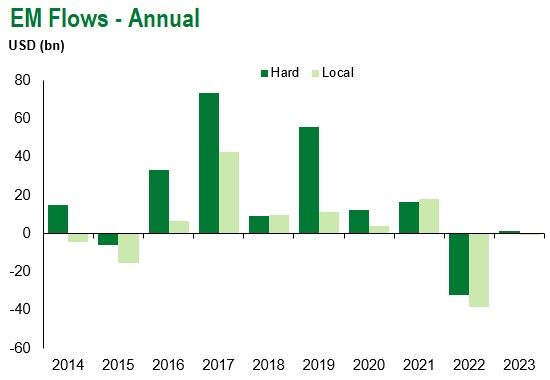
Source for graphs: Bloomberg, JPMorgan, Gramercy. As of March 17, 2023.
For questions, please contact:
Kathryn Exum, CFA ESG, Director, Co-Head of Sovereign Research, [email protected]
Petar Atanasov, Director, Co-Head of Sovereign Research, [email protected]
James Barry, Director, Deputy Portfolio Manager, [email protected]
This document is for informational purposes only. The information presented is not intended to be relied upon as a forecast, research or investment advice, and is not a recommendation, offer or solicitation to buy or sell any securities or to adopt any investment strategy. Gramercy may have current investment positions in the securities or sovereigns mentioned above. The information and opinions contained in this paper are as of the date of initial publication, derived from proprietary and nonproprietary sources deemed by Gramercy to be reliable, are not necessarily all-inclusive and are not guaranteed as to accuracy. This paper may contain “forward-looking” information that is not purely historical in nature. Such information may include, among other things, projections and forecasts. There is no guarantee that any forecasts made will come to pass. Reliance upon information in this paper is at the sole discretion of the reader. You should not rely on this presentation as the basis upon which to make an investment decision. Investment involves risk. There can be no assurance that investment objectives will be achieved. Investors must be prepared to bear the risk of a total loss of their investment. These risks are often heightened for investments in emerging/developing markets or smaller capital markets. International investing involves risks, including risks related to foreign currency, limited liquidity, less government regulation, and the possibility of substantial volatility due to adverse political, economic or other developments. References to any indices are for informational and general comparative purposes only. The performance data of various indices mentioned in this update are updated and released on a periodic basis before finalization. The performance data of various indices presented herein was current as of the date of the presentation. Please refer to data returns of the separate indices if you desire additional or updated information. Indices are unmanaged, and their performance results do not reflect the impact of fees, expenses, or taxes that may be incurred through an investment with Gramercy. Returns for indices assume dividend reinvestment. An investment cannot be made directly in an index. Accordingly, comparing results shown to those of such indices may be of limited use. The information provided herein is neither tax nor legal advice. Investors should speak to their tax professional for specific information regarding their tax situation.
